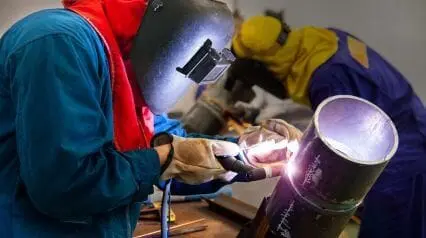What is Gas Welding?
Gas welding is a process used to melt and then join metal parts, this involves fuel—specifically acetylene—in combination with oxygen to generate high-temperature flames of up to 3,200 degrees Celsius. Due to its versatility, portability, and cost-effectiveness, welding with gas is still one the most favored choices since other options require specialized skill. This method is utilized in various applications across industries, including automotive, construction, and manufacturing.
Brief History
Metal forging is one of the oldest crafts, dating back 3000 B.C. when ancient civilizations created weapons, jewelry, and dining utensils. The practice continued in the Middle Ages, making blacksmithing important as wares like locks, nails, horseshoes, and armors were in-demand. But it wasn’t until the Industrial Revolution when modern welding methodologies were introduced.
In 1800, Sir Humphry Davy observed the creation of an arc between two carbon electrodes. This discovery opened the possibility of joining metals by focusing the arc’s heat. Three decades later, his cousin Edmund Davy discovered the use of acetylene, which boosted shipbuilding, railroad construction, and other industrial fabrications.
Equipment
To understand this welding system better, take a look at the required equipment. Aside from the two pieces of metals that need to be joined, here are the must-haves:
- Fuel Cylinder – As the term implies, this contains the fuel which will heat up the metal. Acetylene is the most suitable because of its heat input. This cylinder is often painted maroon or claret.
- Oxygen Cylinder – The second gas canister in the system contains pure compressed oxygen. This supports the flame created by the acetylene, making it burn hotter and more concentrated. This is usually painted black.
- Regulators and Control Valves – Both the cylinders have regulators as they store the gases at high pressure. Control valves are used to ensure the right acetylene to oxygen ratio.
- Mix Chamber – This mixes the fuel and the oxygen, making sure that it has the right amount of gases from the cylinders to create the perfect flame.
- Welding Torch – At the end of the hoses from the fuel and oxygen canisters is the torch which the technician holds. Once turned on, the gases ignite at the end of the nozzle, melting and then melding the metal sections.
Gas welding does not always require a filler material – one of the reasons why it is a cheaper option compared to other kinds of welding like MIG (Metal Inert Gas) or FCAW (Flux-Cored Arc Welding).
Techniques
Gas welding has different types, depending on the fuel used. Here are the most common:
- Oxy-Acetylene Welding (OAW) – This is the most common technique since acetylene, as aforementioned, has the best combustion capability of all fuels used for welding.
- Oxy-Hydrogen Welding (OHW) – As the name suggests, this makes use of hydrogen instead of acetylene. This is chosen when working with aluminum or when welding or cutting underwater because it can handle high-pressure conditions. Hydrogen cylinders are colored bright red.
- Pressure Gas Welding (PGW) with other fuels – Gases like propane, butane, and propylene are also used for this welding method but, because they cannot reach the optimal temperatures of acetylene or hydrogen, they are instead used to cut, braze, and solder.
Applications
Despite the emergence of more high-tech welding methods like plasma, laser, and electron beam welding, gas welding with oxy-acetylene is still quite common these days and is continually used in various industries:
- Automotive repair and restoration – Gas welding is preferred by mechanics because it allows them to maneuver the tool in small, tight spaces. They can easily repair and fabricate replacement for vehicle panels and frames, exhaust pipes and mufflers, cylinder heads and blocks of engines, and roll cages, among others.
- Construction and metal fabrication – It may be considered a more traditional approach but because gas welding can bind ferrous (steel, cast iron, wrought iron) and non-ferrous materials (aluminum, brass, copper, etc.), it is the go-to method in construction.
- Plumbing and HVAC installation – Since it is cost-effective, gas welding is the preferred mode for pipefitting. It is also incredibly versatile as it is used for brazing, soldering, and cleaning.
- Artistic metalwork – Gas welding is favored by artisans because it is perfect for binding thin sheets or ropes of metal, which they often work with. It is also easy to learn, even amateurs without certifications can use this for their creations.
Improve your EHS Management
Cultivate a safe working environment and streamline compliance with our EHS solutions.
Explore nowSafety Precautions
Serious injuries face welders when they do not adhere to basic safety precautions during hot work procedures. Potential hazards include eye damage due to the heat, burns from the sparks, exposure to toxic fumes and radiation, and many more. Fortunately, these are all preventable when both the worker and their employers are serious about following protocols.
- Ensuring proper ventilation – If possible, gas welding must be done in a dry, open space, barricading the worker from other people, to prevent accidental toxic fume inhalation. If the workspace is enclosed, ventilation strategies like installation of exhausts should be applied.
- Wearing of complete PPE – Full welding protective equipment includes a helmet or goggles, respirator, fire resistant suits or aprons, ear muffs or plugs, a pair of heavy duty boots, and gloves.
- Upholding fire safety – Gas and flame are recipes for disaster. Aside from having a fire extinguisher ready nearby, welders should be aware where the torch or flame is pointed. The cylinders must be as far from the torch as possible and there shouldn’t be any combustible materials (e.g., papers, sawdust, open sewers, aluminum chips) in the immediate work space or line of fire. Remember that even the sparks could cause fire.
- Proper gas cylinder labeling and handling – Understanding the different gases utilzed and their individual properties is a must. Even if the cylinders are color coded, these must be properly labeled. Pressure regulators and gauges should be working and their levels continuously monitored.Note also that these gases are stored in compressed chambers, also called pressure vessels, and have the possibility of exploding if handled improperly. Canisters should not be close to the worker once the torch is on. These must be stored upright in dry and ventilated spaces and should be regularly inspected.
- Following proper set-up and tear-down procedures – Pre-work inspection includes checking the regulators, gauges, hoses, and electrical lines, making sure everything is functional. Doing a quick sweep of your surrounding is also important before starting work. After welding, ascertain that the hoses are purgedm the pressure is bled, and the cylinders completely shut.




